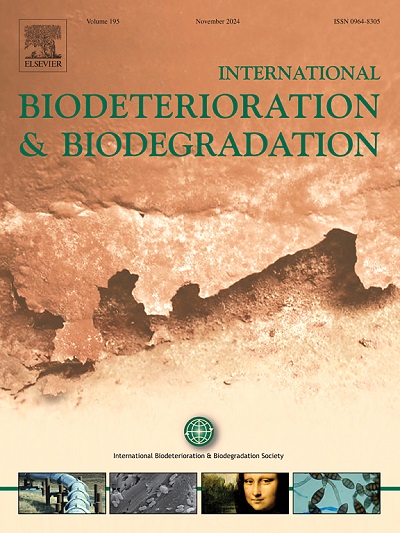频繁Stutzerimonas frequens SL-6降解菲过程中1-羟基-2-萘酸积累机制的研究
IF 4.1
2区 环境科学与生态学
Q2 BIOTECHNOLOGY & APPLIED MICROBIOLOGY
International Biodeterioration & Biodegradation
Pub Date : 2025-02-01
DOI:10.1016/j.ibiod.2024.105975
引用次数: 0
摘要
含氧多环芳烃(oxy-PAHs)是多环芳烃降解过程中积累的中间代谢物,对多环芳烃污染的有效修复提出了挑战。值得注意的是,1-羟基-2-环烷酸(1H2N)以其高毒性而闻名,成为研究羟基多环芳烃的关键模型化合物。本研究旨在揭示Stutzerimonas frequens SL-6(一种高效的菲降解细菌)积累1H2N的机制。S. frequens SL-6的基因组分析表明nahA、salA和nahR参与了1H2N的积累过程。这一假设通过酶催化活性的体外评估得到验证,并通过体内基因敲除和互补研究得到加强。我们的研究结果指出SalA是1H2N积累的关键因素。随后,SalA在S. frequens SL-6中的过表达导致1H2N积累减少70%。这些见解加深了全球对微生物降解多环芳烃过程的认识,并为开发能够高效彻底降解多环芳烃的微生物菌株提供了理论基础。本文章由计算机程序翻译,如有差异,请以英文原文为准。
Insights into mechanism of 1-hydroxy-2-naphthoic acid accumulation during phenanthrene degradation by Stutzerimonas frequens SL-6
Oxygenated polycyclic aromatic hydrocarbons (oxy-PAHs) represent intermediate metabolites accumulating during the degradation of polycyclic aromatic hydrocarbons (PAHs), posing challenges to effective remediation of PAH contamination. Notably, 1-hydroxy-2-naphthoic acid (1H2N), distinguished by its heightened toxicity, emerges as a pivotal model compound for investigating oxy-PAHs. This research endeavors to unravel the mechanism behind the accumulation of 1H2N by Stutzerimonas frequens SL-6, an efficient phenanthrene-degrading bacterium. Genomic analysis of S. frequens SL-6 implicated nahA, salA, and nahR in the accumulation process of 1H2N. This hypothesis was validated through in vitro assessments of enzyme catalytic activity, reinforced by in vivo gene knockout and complementation studies. Our findings pinpoint SalA as a critical factor in the accumulation of 1H2N. Subsequently, the overexpression of SalA in S. frequens SL-6 led to a 70% reduction in the accumulation of 1H2N. These insights deepen the global understanding of microbial PAHs degradation processes and provide a theoretical foundation for the development of microbial strains capable of efficiently and thoroughly degrading PAHs.
求助全文
通过发布文献求助,成功后即可免费获取论文全文。
去求助
来源期刊
CiteScore
9.60
自引率
10.40%
发文量
107
审稿时长
21 days
期刊介绍:
International Biodeterioration and Biodegradation publishes original research papers and reviews on the biological causes of deterioration or degradation.

 求助内容:
求助内容: 应助结果提醒方式:
应助结果提醒方式:


